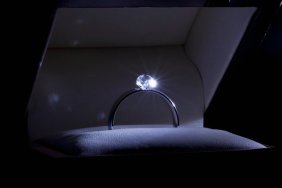They say diamonds are a woman’s best friend, but to men they’re the devil. They say diamonds are forever, and yet the divorce rates in America have leveled off at an all-time high. With the romantic Valentine’s Day weekend coming up, diamonds are no strangers to the wish lists of ladies any more than a new Xbox is to ours.

Whether engagement, anniversary or just for the hell of it, those glittering devils put men literally between a rock and a hard place with one of America’s most misinterpreted traditions: the diamond ring. But maybe diamonds aren’t forever.
There are a great many things we assume as a culture, ideas that swirl around with little validity to them, and one such thing is the ancient engagement ritual of diamond rings. Since the 1930s, diamonds have become an increasing phenomenon in American culture without actually having any real legitimate connection to the emotions between two people. This tradition isn’t actually that old, either, but instead was propagated by the wealthy businessmen of the largest diamond-distributing ring, De Beers, less than a century ago. Their campaign “diamonds are forever” in 1948 linked love, devotion and everlasting marriage – two out of three things that are rare today – to diamond rings in one of the most profitable marketing operations of all time, thinning men’s wallets and giving women something to show off more than their supple, silicon pound puppies.
A lot is known by the people of the diamond industry, but little else by the rest of society, in terms of how abundant and overpriced these not-so-rare gems are. When you boil it down, diamonds are nothing more than a clever gift-giving invention made by suited men who saw an opening in the market for women’s endless desire of shiny trinkets, like Valentine’s Day on a kilo of blow.
For most guys, a diamond engagement ring is a necessary evil or a gesture of goodwill to support his lady, but the single expense of a diamond ring is growing with every decade as women’s eyes get bigger and suddenly men are spending loot they never had. Today, the average yearly income for men between 25 and 34, the most common bracket for engagements, is somewhere around 45 to 50 thousand – with the 50k being toward the elder end of the spectrum – and although the average cost of a diamond ring is four to six grand, some guys are forced to overspend for fear of not having the biggest dick on the tree of marital ornaments.
People see love in proportion to the size of the diamond a guy buys his lady, as if a modest ring signifies less commitment than an 18-carat rock might. Or to look at it another way, like the love of a guy on a high school teacher’s salary is less than that of a rich banker or professional athlete.
The only misconception bigger than diamonds measuring a man’s intentions is diamonds equaling gold. They make awful investments, as the demand for diamonds never goes away but the resale value is diminished more than a car driven off the lot and brought back without its doors. Diamonds may seem like rare stones to prospective suckers, but since the early 20th century, diamond hoarders like De Beers create the illusion of demand while they actually sleep on a stack of stones at night, driving the cost way up. Then, in the

unfortunate occasion when the girl can’t bring herself to say “yes” despite the kind gesture, a guy can only retrieve of a fraction of his money after only a few weeks have past since his splurge.
There’s no other time in a man’s life he’ll spend as much money on something that is so purely superficial and superfluous. Any large purchase – a car, education or house – either has a purpose or is an investment that can generate money in the future, whereas diamond rings have price tags well above their worth, and fictional demand forces people to pay two to four times what they’re worth. Hell, crack cocaine is a rock with more street value than a box of shiny rocks.
Oh, and don’t forget about blood diamonds! That’s a thing too. Leo wouldn’t do a movie about it if those weren’t real things. Blood diamonds are stones collected in war zones through the exploitation of vicious child labor in order to finance dirty wars, and the stones are later filtered into the clean diamond supply like a good old fashion money-laundering scheme. So if you’re into carrying on traditions of man, there’s another one to add to your list.
It’s not all about money here; it’s about placing value on something that has no real significance except to an overtly materialistic society that doesn’t know any better. But we wouldn’t bag on a long-held tradition – however senseless – without offering a healthy alternative. Instead of going to the jewelry store three times only to buy the ring you promised yourself you wouldn’t and setting yourself back half a year’s salary, why not find something that shows more thought than the same ring every man brings to the alter this century? Why not find an actual rare stone, a family heirloom or something that speaks volumes specifically to her personality, your relationship and the life you want together? Then take the money you save and travel together, put a down payment on a nicer house – something real – for yourselves and sleep soundly without the anxiety of a shiny devil she might lose down the drain.
If none of this makes sense to you and you’re hell-bent to buy a diamond, why not have it be an unexpected surprise on your wedding day, knowing your wife said yes to you and not some shiny stone? Maybe if diamonds were placed somewhere unexpectedly later in the timeline, perhaps divorce rates will do more than just level off at abnormally high. Maybe then you’d be the little devil she wants.









